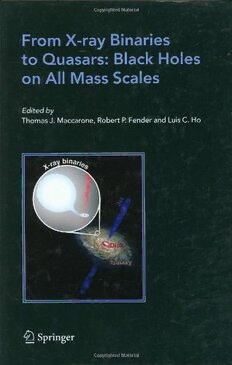
From X-Ray binaries to quasars: Black holes on all mass scales PDF
Preview From X-Ray binaries to quasars: Black holes on all mass scales
ASTROPHYSICS AND SPACE SCIENCE FromX-RayBinariestoQuasars:BlackHolesonallMassScales FROM X-RAY BINARIES TO QUASARS: BLACK HOLES ON ALL MASS SCALES Editedby: T.J.MACCARONE,R.P.FENDERandL.C.HO ReprintedfromAstrophysicsandSpaceScience Volume300,Nos.1–3,2005 LibraryofCongressCataloging-in-PublicationDataisavailable ISBN1-4020-4084-9 2003055495 Published bySpringer, P.O.Box17,3300AADordrecht,TheNetherlands. Printedonacid-freepaper AllRightsReserved (cid:1)c Springer2005 Nopartofthematerialprotectedbythiscopyrightnoticemaybereproducedor utilizedinanyformorbyanymeans,electronicormechanical, includingphotocopying,recordingorbyanyinformationstorage and retrievalsystem,without writtenpermissionfromthecopyrightowner. PrintedintheNetherlands TABLEOFCONTENTS R.FENDER,T.BELLONIandE.GALLO/AUnifiedModelforBlackHole X-RayBinaryJets? 1–13 S. HEINZ, A. MERLONI, T. DI MATTEO and R. SUNYAEV / On the RelationshipBetweentheJetsfromX-RayBinariesandAGN 15–21 A.CELOTTI/ATransitionintheAccretionPropertiesofAGN 23–30 J. MALZAC, A. MERLONI and A.C. FABIAN / Jet-Disc Coupling in the AccretingBlackHoleXTEJ1118+480 31–38 A.P.MARSCHER/Are3C120andOtherActiveGalacticNucleiOverweight Microquasars? 39–44 A. MERLONI, S. HEINZ and T. DI MATTEO / A Fundamental Plane of BlackHoleActivity:PushingForwardtheUnificationScheme 45–53 D.L.MEIER/MagneticallyDominatedAccretionFlows(MDAFS)andJet ProductionintheLowhardState 55–65 J.C.LEE/BlackHoleSystemsSeenatHighSpectralResolution:Inflowand Outflow 67–70 C.S.REYNOLDS,L.W.BRENNEMANandD.GAROFALO/BlackHole SpininAGNandGBHCs 71–79 R.L.C. STARLING, M.J. PAGE, G. BRANDUARDI-RAYMONT, A.A. BREEVELD,R.SORIAandK.WU/TheSeyfert-LinerGalaxyNGC 7213:AnXMM-NewtonObservation 81–86 K.BECKWITHandC.DONE/ObservationalEffectsofStrongGravity 87–96 A.C.FABIAN/BroadIronLinesinAGNandX-RayBinaries 97–105 J.HOMANandT.BELLONI/TheEvolutionofBlackHoleStates 107–117 S.VAUGHAN,A.C.FABIANandK.IWASAWA/RapidX-RayVariability ofSeyfert1Galaxies 119–125 M.A.ABRAMOWICZandW.KLUZ´NIAK/EpicyclicFrequenciesDerived fromtheEffectivePotential:SimpleandPracticalFormulae 127–136 K.M.LEIGHLY/X-RayPeriodicityinAGN 137–142 W. KLUZ´NIAK and M.A. ABRAMOWICZ / Resonant Oscillations of AccretionFlowandkHzQPOS 143–148 M. VAN DER KLIS / Comparing Black Hole and Neutron Star Variability 149–157 M.NOWAK/X-RayandRadioMonitoringofGX339-4andCYGX-1 159–166 C.DONEandM.GIERLIN´SKI/AccretioninStrongGravity:FromGalactic toSupermassiveBlackHoles 167–175 R. NARAYAN / Low-Luminosity Accretion in Black Hole X-Ray Binaries andActiveGalacticNuclei 177–188 S.MARKOFF/ExploringtheJet/AccretionFlowRelationshipinLowDisk LuminositySources 189–195 S. MIGLIARI and R. FENDER / What Can We Learn from Neutron Star X-RayBinaries’Jets? 197–209 E. KO¨RDING and H. FALCKE / A Unifying Scheme for Low-Luminosity XRBsandAGN 211–217 L.C.HO/“Low-State”BlackHoleAccretioninNearbyGalaxies 219–225 J.M.MILLER/PresentEvidenceforIntermediateMassBlackHolesinULXs andFutureProspects 227–238 T.J. MACCARONE, R.P. FENDER and A.K. TZIOUMIS / Finding Faint Intermediate-MassBlackHolesintheRadioBand 239–245 S.F.PORTEGIESZWART,J.DEWIandT.MACCARONE/Formationand EvolutionofIntermediateMassBlackHoleX-RayBinaries 247–253 F. AHARONIAN and A. NERONOV / TeV Gamma Rays from the Galac- tic Center Direct and Indirect Links to the Massive Black Hole in SgrA 255–265 J.M. PAREDES / AGNs and Microquasars as High-Energy γ-Ray Sources 267–274 S.CORBEL/LargeScaleJetsinMicroquasars 275–281 C.R. KAISER, J.L. SOKOLOSKI, K.F. GUNN and C. BROCKSOPP / Is GRS1915+105aMicroquasar? 283–288 AUNIFIEDMODELFORBLACKHOLEX-RAYBINARYJETS? ROBFENDER1,TOMASOBELLONI2andELENAGALLO3 1SchoolofPhysics&Astronomy,UniversityofSouthampton,SO171BJ,UK; E-mail:[email protected] 2INAF—OsservatorioAstronomicodiBrera,ViaE.Bianchi46,I-23807Merate,Italy 3AstronomicalInstitute‘AntonPannekoek’,UniversityofAmsterdam,Kruislaan403, 1098SJAmsterdam,TheNetherlands (Received8April2005;accepted1June2005) Abstract.Wehaverecentlyputforwarda‘unified’semi-empiricalmodelforthecouplingbetween accretionandjetproductioningalacticblackholeX-raybinaries.Inthispaper,wesummarisethis modelandbrieflydiscussrelevantconsiderationsthathavearisensinceitspublication. Keywords:accretion,blackholephysics,ISM:jetsandoutflows 1. Introduction Relativisticjetsareafundamentalaspectofaccretionontoblackholesonallscales. Theycancarryawayalargefractionoftheavailableaccretionpowerincollimated flows which later energise particles in the ambient medium. The removal of this accretionpowerandangularmomentummusthaveadramaticeffectontheoverall processofaccretion.Intheirmostspectacularformtheyareassociatedwithsuper- massive black holes in active galactic nuclei (AGN), and with gamma-ray bursts (GRBs), the most powerful and explosive engines in the Universe, respectively. However,parallelprocesses,observableonhumanlyaccessibletimescales,areoc- curringintheaccretionontoblackholesandneutronstarsinbinarysystemswithin ourowngalaxy. We (Fender et al., 2004; hereafter FBG04) have recently published a ‘unified’ model for the ‘disc–jet’ coupling in galactic black hole binaries. In the next few pagesweshallquicklysummarisethismodel. 2. TheModel Inourmodel,weattempttopindownasaccuratelyaspossiblethemomentatwhich the major radio outburst occurred and relate this to the X-ray state at the time. We subsequently compare this with the X-ray state corresponding to the lower- luminosity steady jets, to the evolution of transient outbursts, and to the velocity AstrophysicsandSpaceScience300:1–13,2005. DOI:10.1007/s10509-005-1201-z (cid:1)C Springer2005 2 R.FENDERETAL. andpowerassociatedwitheach‘type’ofjet,inordertodrawupaframeworkfor aunifiedmodelofblackholeX-raybinaryjetproduction. Severalblackholesystemsareinvestigatedinthispaper,andinadditionwecom- parethesewiththeneutronstarsystemsCirX-1andScoX-1.Thedatarelatingto theradioflares,jetLorentzfactors(ifmeasured),correspondingX-rayluminosities, estimateddistancesandmasses,aresummarisedinTableI ofFBG04.InFBG04, we focus in particular on the spectral evolution of four black hole binaries, GRS 1915+105,GX339-4,XTEJ1859+226andXTEJ1550-564.Precisedetailsofthe X-raydataanalysisarepresentedinFBG04.Figure1presentstheX-ray(fluxand hardness) and radio flux of these four systems around periods of state transitions. Severalkeyfeaturesareapparentfromcarefulinspectionofthisfigure,inparticular, theopticallythinradiooutburstsoccuraroundthetransitionfrom‘hardVHS(very highstate)/IS(intermediatestate)’to‘softVHS/IS’states,andnotatthetransitions toorfromthecanonicallow/hardorhigh/softstates. 3. JetsasaFunctionofX-RayState:NewPerspectives Basedupontheinvestigationwehaveperformed,wearebetterabletoassociatethe characteristics of the radio emission as a function of X-ray state, and therefore to probethedetailsofthejet–disccoupling.Whilethepreviouslyestablishedpattern of • LS(lowstate):steadyjet • HS(highstate):nojet remainsvalid,additionalinformationhasclearlycometolightaboutthedetailsof jetformationintheVHS/ISduringtransientoutbursts. 3.1. BEHAVIOUR OF THE JET IN THE ‘HARD VHS/IS’ Itwaspreviouslyestablishedthatthecanonicallow/hardstatewasassociatedwith a steady jet, the emission from which followed a ‘universal’ correlation in the L :L plane(e.g.Fender,2001;Corbeletal.,2003;Galloetal.,2003).Further- X radio more the canonical ‘high/soft’ state was associated with a dramatic reduction in theradioemission(Tanabaumetal.,1972;Fenderetal.,1999;Galloetal.,2003). The study presented in FBG04 has further revealed that almost until the point of the major ejection, after the spectrum has started softening (in the ‘hard VHS/IS’ state)thesteadyradiojetstays‘on’. However,followingthepersistenceofthesteadyLS-likeradioemissionintothe hard VHS/IS, the data do indicate that a change in the radio emission does occur priortotheradioflare.Inbrief,itappearsthattheradioemissionstartstobecome more variable, with a peaked or (more) optically thin spectrum shortly before the radioflare.Atpresentwedonothaveaclearpictureofwhatisgoingonduringthis AUNIFIEDMODELFORBLACKHOLEX-RAYBINARYJETS 3 GRS 1915+105 GX 339-4 120 55 Ryle 15 GHz ATCA 4.8 GHz 110 50 Radio flux density 1 0678900000 (a) Radio flux density 223344050505 (b) 50 15 40 10 Hard Alternating Soft Hard VHS/IS Soft VHS/IS LS V/IHSS VHS/IS / HS VHS/IS peak LS peak VHS/IS peak 2.5e-07 1.5e-08 0.001-100 keV 0.001-100 keV 2e-07 X-ray flux 1. 51ee--0077 X-ray flux 1e-08 5e-08 5e-09 0.2 0.9 X-ray colours 00 0..01.155 (15.2-42.3 keV)/(2.1-5.9 keV) X-ray colours 0000000.......2345678 (6.3-10.5 keV)/(3.8-6.3 keV) 0 0.1 1600 1800 2000 2200 2400 40 50 60 70 80 90 100 Time (seconds) Days (MJD-52339) XTE J1859+226 XTE J1550-564 120 300 Ryle 15 GHz ATCA 5 GHz 100 (c) MERVLLIAN 41..97 GGHHzz 250 (d) Radio flux density 468000 Radio flux density 112050000 20 50 0 0 Hard Alternating Hard/Soft LS VHS/IS Alternating soft/hard VHS/IS LS Hard VHS/IS VHS/IS LS peak VHS/IS peak LS peak VHS/IS peak 7e-08 2.5e-07 6.5e-08 0.001-100 keV 0.01-100 keV 6e-08 2e-07 5.5e-08 X-ray flux 34 ..4555eeee----00008888 X-ray flux 1 .15ee--0077 3e-08 2.5e-08 5e-08 2e-08 1.5e-08 0.8 0.7 X-ray colours 000000......234567 (6.3-10.5 keV)/(3.8-6.3 keV) X-ray colours 0000....3456 (6.3-10.5 keV)/(3.8-6.3 keV) 0.1 0.2 0 5 10 15 20 25 30 60 65 70 75 80 85 90 95 100 Days (MJD-51460) Days (MJD-51000.0) Figure1. RadioandX-raylightcurves,X-raycoloursandX-raystateclassificationsduringperiods aroundtransientjetformation,forfourblackhole(candidate)X-raybinaries.InGRS1915+105the canonicalLSorHSareneverreached;inGX339-4,XTEJ1859+226andXTEJ1550-564thedelay betweenthecanonicalLSpeakandsubsequentVHS/ISpeakrangesfromafewdaysto2weeks. Nevertheless,inallfourcasestheradioflareoccursatthetimeoftheVHSpeak,indicatingaclear associationbetweenthis,andnotthepreviousLS,andthemajorejection.TheunitsoftheX-rayflux areergs−1cm−2. 4 R.FENDERETAL. 1 HS LS n o gt n di 0.1 d E y / sit o n mi u V l 0.01 e k 0 8 2- GX 339-4 XTE J1859+226 XTE J1550-564 0.001 0 0.2 0.4 0.6 0.8 1 X-ray colour Figure2. CombinedX-rayhardness–luminositydiagramforGX339-4,XTEJ1859+226andXTE J1550-564.TheX-rayfluxesplottedinFigure1b–1dhavebeenscaledtoEddington-ratioedlumi- nosities;allthesourcesmoveapproximatelyanti-clockwiseinthediagram.NotethatejectionsinGX 339-4andXTEJ1859+226occuratalmostexactlythesamecolourandX-rayluminosity.Mostof thedatapointscorrespondtovaryingdegreesoftheVHS/IS,andnotthecanonicalLS(totheright) orHS(totheleft). phase, but it hints that the major ejection episode is already inevitable some days inadvanceofitsobservationalsignature.SeeFBG04formoredetails. 3.2. ASSOCIATION OF THE OUTBURST WITH THE SOFT VHS/IS PEAK TheclearestobservationalfacttobegleanedfromFigure1isthatthemajoropti- callythinradiooutburstsoccurinatransitionfromthe‘softVHS/IS’tothe‘hard VHS/IS’. Figure 2 indicates the point of radio outburst in hardness–luminosity plane. This aspect is discussed in considerably more detail in FBG04 but it suf- fices to note here that to our knowledge there are no exceptions to this pattern of behaviour in any black hole X-ray binary. It is important to note that very similar conclusions about the behaviour of the radio emission in the VHS/IS were drawn byCorbeletal.(2004). 4. IncreasingJetVelocityinOutburst? InFigure3,weplotestimatedlimitsontheLorentzfactorsofjetsfromahandful of X-ray binary systems as a function of X-ray luminosity at the point of the jet launch.Itisimportanttorealisethatthelower-leftpointisanupperlimitonthemean Lorentz factor of jets in the low/hard state (Gallo et al., 2003; but see also Heinz
